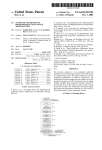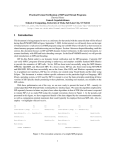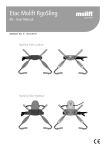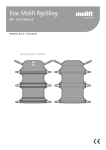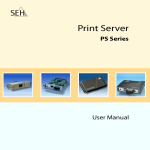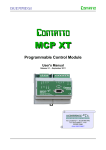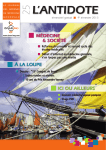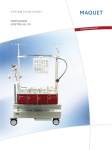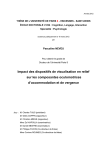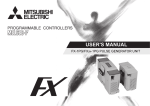Download Method of determining FET source/drain wire, contact, and diffusion
Transcript
US008479131B2 (12) United States Patent (10) Patent N0.: (45) Date of Patent: Dewey, III et al. (54) METHOD OF DETERMINING FET SOURCE/DRAIN WIRE, CONTACT, AND DIFFUSION RESISTANCES IN THE PRESENCE OF MULTIPLE CONTACTS (75) Inventors: Lewis W. Dewey, III, Wappingers Falls, NY (U S); Ning Lu, Essex Junction, VT (US); Judith H. McCullen, Essex Junction, VT (US); Cole E. Zemke, Essex Junction, VT (US) (73) Assignee: International Business Machines Corporation, Armonk, NY (US) (*) Notice: Subject to any disclaimer, the term of this patent is extended or adjusted under 35 U.S.C. 154(b) by 155 days. Jul. 2, 2013 FOREIGN PATENT DOCUMENTS JP JP 2003 -223478 2006-260200 8/2003 9/2006 OTHER PUBLICATIONS Lu, Ning; Dewey, Bill; “Characterization, Simulation, and Modeling of PET Source/Drain Diffusion Resistance,” 2008, IEEE.* Wong, Waisum; Shao, Fang; Huang, Andy; Ko, Tienchi; Lee, Scott; Qian, Weihong; Liao, Chinchang; Gao, Xiaofang; TaZlauana, Mihai; Liu, Weidong; “Scalable Modeling of MOSFET Source and Drain Resistances for MS/RF Circuit Simulation,” 2006, IEEE.* BSIM4.5 MOSFET Model, User’s Manual, UC Berkeley, Chapter 11, “Layout-Dependent Parasitics Model,” 2003, 9 pages. BSIM4.5 MOSFET Model, User’s Manual, UC Berkeley, Appendix A.11, “Layout-Dependent Parasitics Model,” 2003, 42 pages. Lu, et al., “Characterization, Simulation, and Modeling of PET Source/ Drain Diffusion Resistance,” IEEE 2008 Custom Integrated Circuits Conference, 2008, pp. 281-284. * cited by examiner (21) App1.No.: 13/038,468 (22) Filed: US 8,479,131 B2 Primary Examiner * Vuthe Siek Assistant Examiner * Eric Lee Mar. 2, 2011 (74) Attorney, Agent, or Firm * Gibb & Riley, LLC; (65) US 2012/0227020 A1 (51) (52) Int. Cl. G06F 17/50 US. Cl. USPC (58) Richard M. Kotulak, Esq. Prior Publication Data Sep. 6, 2012 (57) effect transistor (FET) device. The method counts the number (2006.01) (N) of contacts in each source/drain region of the FET device, partitions each source/ drain region into N contact regions and ......................................... .. 716/110;716/115 Field of Classi?cation Search USPC ........................................................ .. 716/110 See application ?le for complete search history. (56) ABSTRACT A method calculates a total source/drain resistance for a ?eld References Cited calculates a set of resistances of elements and connections to the FET device. The measured dimensions of Widths, lengths, and distances of layout shapes forming the PET and the connections to the FET are determined and a set of Weights based on relative Widths of the contact regions are computed. The total source/drain resistance of the FET device is deter mined by summing products of the set of resistances and the Us‘ PATENT DOCUMENTS 5,461,579 A 10/ 1995 Misheloff et 31 set of Weights for each of a plurality of contacts in series, the summing being performed for all of the plurality of contacts 5,896,300 A 6,438,729 B1 in one of a source region and a drain region of the FET. A t1. t. f db d th t t 1 . t dt t 1 6,665,845 B1 4/1999 Raghavan et a1‘ 8/2002 Ho 12/2003 Aingamn et a1‘ 6,854,103 B2 7,114,137 B2 2/2005 Teene 9/2006 Hayashi 7,320,116 B2 l/2008 Mukaihira ne ‘1s 1s .orme ase on e o'a source res1s ance an dram res1stance of the FET device. 19 Claims, 12 Drawing Sheets DETERMINING, BYA COMPUTING DEVICE, PHYSICAL RESISTANCES OFA WIRE ’\ 500 RESISTANCE (!),ACONTACT RESISTANCE (Ru), ANDADIFFLISION RESISTANCE I I FOR EACH OF THE PLURALITV OF CONTACTS I I DETERMININGACONTACTIDIFFLISION RESISTANCE WEIGHT I DETERMININGAWIRE RESISTANCE WEIGHT IASOZ p504 DETERMINING AN EFFECTIVE RESISTANCE IRE’) FOR EACH OF THE FLURALITY “505 OF CONTACTS BY SUMMING IN SERIES FOR EACH PARTICULAR CONTACT THE PRODUCTS OF: 1)THE WIRE RESISTANCE WEIGHTAND THE WIRE RESISTANCE In, 2) THE CONTACT/DIFFUSION RESISTANCE WEIGHTAND THE CONTACT RESISTANCE (Ru), AND 3) THE CONTACT/DIFFUSION RESISTANCE WEIGHTAND THE DIFFUSION RESISTANCE (R). DETERMINING, BY THE COMPUTING DEVICE, ATOTAI. SOURCE/DRAIN RESISTANCE (Rm) FOR ONE OF A SOURCE REGION AND A DRAIN REGION BY SUMMING IN SERIES EACH OF THE EFFECTIVE RESISTANCES (R5,) FOR CONTACTS CONTAINED IN ONE OF THE SOURCE REGION AND THE DRAIN REGION, RESPECTIVELY 608 OUTPUTTING ONE OF THE EFFECTIVE RESISTANCES (R5,) FOR EACH OF THE PLURALITV OF CONTACTS AND THE TOTAL SOURCE/DRAIN RESISTANCE (RM) FOR ONE OF THE SOURCE REGION AND THE DRAIN REGION 610 o a US. Patent Jul. 2, 2013 Sheet 1 or 12 DRAIN /\112 Fig. 1 CA3 M1 US 8,479,131 B2 US. Patent Jul. 2, 2013 Sheet 2 or 12 N9 .mt w US 8,479,131 B2 US. Patent Jul. 2, 2013 Sheet 3 0f 12 mozm .QE m US 8,479,131 B2 US. Patent Jul. 2, 2013 Sheet 4 or 12 US 8,479,131 B2 N8 $58 L@292 @8\S52 m m Q _:>_<0 <@ bu .5sT v m8, 0;, m 85 65 is m n vm“ hes $5 .55 vm“vA n wow ‘m "N 2? n 3s kmV A Q m 5sJ“ 35 33 v““vA at v 1% y"H ‘T Emg W5 “NOE m8: \7.8m 22%@ US. Patent Jul. 2, 2013 Sheet 6 0f 12 US 8,479,131 B2 1%,?5%Es?+ H SEwxSk at m US. Patent Jul. 2, 2013 Sheet 8 0f 12 US 8,479,131 B2 A i J ET\ 27\ 5K 25K QEK 5k % N:5K NQK 5K \/ 5 .mE m 5 US. Patent Jul. 2, 2013 Sheet 9 0f 12 US 8,479,131 B2 N5 woo mom : Soom 7 \9SE>652m%:5 \\:2>$9385: w2m965o:8mi mom 6 o 25% Emmom Bamom \\92:m5w:062ow:mAa\2$o5E5:290065 \m;9:52\@m0 :2 \@5=25=QE¢ $392?2mxzw8 88m \.52:0m \ \\QEQE£29$=5:68m0w29 E5_EA|9_5>822 6w $5E=omx SE5 mow mow Now >E5m:2 $5026 wow 22mm at m82 SE23 $26 US 8,479,131 B2 1 2 METHOD OF DETERMINING FET mined by summing in series for each particular contact the products of: the Wire resistance Weight and the Wire resistance (r); the contact/diffusion resistance Weight and the contact resistance (RCA), and the contact/diffusion resistance Weight and the diffusion resistance (R). A total source/drain resis SOURCE/DRAIN WIRE, CONTACT, AND DIFFUSION RESISTANCES IN THE PRESENCE OF MULTIPLE CONTACTS BACKGROUND tance (Rtot) for one of a source region and a drain region is The present invention relates to a method of calculating the total source/ drain resistance for a ?eld effect transistor (FET) tances (REf) for contacts contained in one of the source region determined by summing in series each of the effective resis and the drain region, respectively. One of the effective resis tances (REf) is output for each of the plurality of contacts and device With multiple contacts in a single source/drain region, and more speci?cally, it relates to a method of extracting and the total source/drain resistance (Rtot) for one of the source netlisting multiple diffusion resistance elements, multiple region and the drain region. contact resistance elements, and multiple segments of Wire A further exemplary aspect of an embodiment herein resistance elements for a FET device With multiple contacts in includes a non-transitory computer storage medium storing computer-readable instruction executable by a computer to a single source/drain region. When a source/ drain region of a FET device (or a bi-polar device or a metal oxide semiconductor varactor) is contacted by multiple contacts, there exists a need to calculate or extract perform a method that determines a total source/drain resis tance for a ?eld effect transistor (FET). The FET includes a plurality of contacts on a Wire (M1) having an intersection total source/ drain resistance of the FET device. In this patent, When We say total source resistance, it includes diffusion resistances, contact resistances, and Wire resistances at a FET’s source side. Similarly, in this patent, When We say total drain resistance, it includes diffusion resistance, contact resistance, and Wire resistance at a FET’s drain side. Using conventional calculation or extraction methods, hoWever, it is dif?cult to correctly calculate or correctly extract and netlist the total source/drain resistance coming from multiple diffu sion resistance elements, multiple contact resistance ele ments, and multiple segments of Wire resistance elements. 20 With a diffusion region (RX) at a ?rst edge of the diffusion region. The diffusion region (RX) has a total diffusion region Width (WRX) de?ned as a dimension betWeen the ?rst edge 25 and a second edge of the diffusion region opposite the inter section at the diffusion region (RX) ?rst edge. The method counts the number (N) of contacts in each source/ drain region of the FET device, partitions each source/drain region into N contact region and determining resistances of a Wire resis tance (r), a contact resistance (RCA), and a diffusion resistance 30 SUMMARY (R) for each of the plurality of contacts to the FET. A Wire resistance Weight and a contact/diffusion resistance Weight are determined. An effective resistance (REf) for each of the plurality of contacts is determined by summing in series for An exemplary aspect of an embodiment herein includes a computer-implemented method that calculates a total source/ drain resistance of a ?eld effect transistor (FET) device. The method counts the number (N) of contacts in each source/ each particular contact the products of: the Wire resistance Weight and the Wire resistance (r); the contact/diffusion resis 35 tance Weight and the contact resistance (RCA), and the con tact/diffusion resistance Weight and the diffusion resistance drain region of the FET device, partitions each source/drain (R). A total source/drain resistance (Rtot) for one of a source region into N contact regions and calculates a set of resis tances of elements and connections to the FET device. The region and a drain region is determined by summing in series each of the effective resistances (REf) for contacts contained measured dimensions of Widths, lengths, and distances of layout shapes forming the FET and the connections to the 40 in one of the source region and the drain region, respectively. One of the effective resistances (RE?) is output for each of the plurality of contacts and the total source/ drain resistance (Rtot) for one of the source region and the drain region. 45 BRIEF DESCRIPTION OF THE SEVERAL VIEWS OF THE DRAWINGS FET are determined and a set of Weights based on relative Widths of the contact regions are computed. The total source/ drain resistance of the FET device is determined by summing products of the set of resistances and the set of Weights for each of a plurality of contacts in series, the summing being performed for all of the plurality of contacts in one of a source FIG. 1 is a typical FET layout With multiple contacts in its source region and multiple contacts in its drain region; region and a drain region of the FET. A netlist is formed based on the total source resistance and total drain resistance of the FET device. 50 Another exemplary aspect of an embodiment herein FIG. 2 schematically shoWs physical Wire, contact, and diffusion resistive elements in source and drain regions for the includes a computer-implemented method that determines a FET layout in FIG. 1; total source/ drain resistance for a ?eld effect transistor (FET). FIG. 3 is a conventional netlist on Wire, contact, and diffu sion resistive elements in source and drain regions for the FET The FET includes a plurality of contacts on a Wire (M1) having an intersection With a diffusion region (RX) at a ?rst 55 edge of the diffusion region. The diffusion region (RX) has a FIG. 4 is a schematic diagram of an embodiment herein; FIG. 5 is a netlist diagram of an embodiment herein; FIG. 6 is an alternative netlist diagram of an embodiment total diffusion region Width (WRX) being de?ned as a dimen sion betWeen the ?rst edge and a second edge of the diffusion region opposite the intersection at the diffusion region (RX) ?rst edge. The method counts the number (N) of contacts in layout in FIG. 1; herein; 60 FIG. 7 is a logic ?owchart diagram of a method of an each source/drain region of the FET device, partitions each source/drain region into N contact regions and determines embodiment herein; resistances of a Wire resistance (r), a contact resistance (RCA), and a diffusion resistance (R) for each of the plurality of contacts to the FET. A Wire resistance Weight and a contact/ diffusion resistance Weight are determined. An effective execution of a transitory computer program thereupon; resistance (REf) for each of the plurality of contacts is deter FIG. 8 is a schematic diagram of a computer system for FIG. 9 is a schematic diagram of a deployment system 65 according to embodiments herein; FIG. 10 is a schematic diagram of an integration system according to embodiments herein; US 8,479,131 B2 4 3 ?rst diffusion edge. The method further includes determining FIG. 11 is a schematic diagram of an on demand system according to embodiments herein; and resistances of a Wire resistance (loWer case r), a contact resis FIG. 12 is a schematic diagram of a virtual private network tance (RCA), and a diffusion resistance (upper case R) for each system according to embodiments herein. of the plurality of contacts. The computer program product includes a non-transitory computer readable storage medium having computer readable program code embodied thereWith, DETAILED DESCRIPTION the computer readable program code causes a computer to determine resistances of a Wire resistance (r), a contact resis One embodiment includes a PET With multiple contacts in a source/drain region. This portion of the disclosure (i) pre tance (RCA), and a diffusion resistance (R) for each of the plurality of contacts, and to determine a Wire resistance Weight and a contact/diffusion resistance Weight. The pro gram code is further con?gured to determine an effective sents a method to extract and netlist multiple diffusion resis tance elements, multiple contact resistance elements, and multiple segments of Wire resistance elements using a para sitic extraction tool, (ii) a method of extracting and calculat ing total FET source/drain resistance, and (iii) a method of generating a much simpli?ed netlist. These methods also resistance (RE?) for each of the plurality of contacts by sum ming in series for each particular contact the products of: l) the Wire resistance Weight and the Wire resistance (r); 2) the contact/diffusion resistance Weight and the contact resistance (RCA); and 3) the contact/ diffusion resistance Weight and the diffusion resistance (R). The program code is further con?g apply to a diffusion region of a MOS varactor. Another embodiment of the present invention calculates a total source/drain resistance of a PET device. This embodi ment calculates a set of physical resistances of the PET, and determines measured dimensions of Widths, lengths, and dis tances of layout shapes forming the PET and connections to ured to determine a total source/ drain resistance (Rtot) for the 20 source region or the drain region by summing in series each of the effective resistances (REf) for contacts contained in the source region or the drain region, respectively, and ?nally output to the effective resistances (REf) for each of the con 25 region or the drain region. A ?rst embodiment comprises a method of calculating the total resistance of PET parasitic elements (such as source/ drain regions and associated contacts), taking into account the FET. This embodiment computes a set of Weights based on the relative siZes of the measured dimensions, and deter mines the total source/ drain resistance of the FET device by summing the products of the set of physical resistances and the set of Weights for each of the contacts (in series), and does tacts and the total source/drain resistance (Rm) for the source so for all of the plurality of contacts in the source region or the drain region. From this, the embodiment forms a netlist based on the determined total source/drain resistance of the FET device. Another embodiment of the present invention deter 30 mines a PET source/drain resistance for a PET that has a plurality of contacts on a Wire (M1) having an intersection With a diffusion region (RX) at a ?rst edge of the diffusion region. The FET has a Width (W) de?ned as a dimension betWeen a ?rst edge of the diffusion region and a second edge 35 of the diffusion region. The ?rst edge of the diffusion region is de?ned as a diffusion edge for electric current ?oW over it in an M1 Wire. In FET layout, the ?rst edge of the diffusion region typically is that diffusion edge Which intersects the Wire (M1). The second edge of the diffusion region is the other edge, Which is opposite the ?rst diffusion edge. The 40 multiple diffusion resistance elements (R), multiple contact resistance elements (RCA), and multiple segments of Wire (M1) resistance elements (r). An additional embodiment includes a method of extracting and netlisting multiple dif?l sion resistance elements, multiple contact resistance ele ments, and multiple segments of Wire resistance elements in the output of a parasitic resistance extraction tool. In the ?rst embodiment, multiple diffusion resistance ele ments, multiple contact resistance elements, and the resis tance elements of multiple Wire segments are included. Here, a PET total source/drain resistance (Rtot) is determined for the source region or the drain region by summing (in series) each of the effective resistances (REf) for contacts contained in the source region or the drain region, respectively. Let the contact number for a source/drain region be N, let j” be the electric method further includes determining resistances of a Wire resistance (loWer case r), a contact resistance (RCA), and a diffusion resistance (upper case R) for each of the plurality of current going into (or coming out of) the nth contact (n:l, contacts. For each contact resistance and associated diffusion resistance, a Weight for its contribution to a total resistance is determined. For the resistance of each Wire segment connect ing tWo contacts, a Weight for its contribution to the total resistance is also determined. Wcightcd rcsistanccs are 45 2, . . . , N). The total electric current passing through that assigned to each diffusion resistance element, each contact resistance element, and each Wire segment resistance ele ment. A total source/drain resistance (Rtot) is determined by 50 segment of M1 Wire Which connects the nth and (n+l)th con tacts is de?ned as: (1) : » H summing (namely, resistive elements being connected in series in a netlist) the products of: l) the Wire resistance Weight and the Wire resistance (r); 2) the contact/diffusion resistance Weight and the contact resistance (RCA); and 3) the 55 tive resistance to the end of the (n+l)th Wire segment, RE?H 1, contact/diffusion resistance Weight and the diffusion resis tance (R). Another embodiment of the present invention includes a computer program product for determining a PET source/ An iteration relationship exists betWeen the effective resis tance to the end of the nth Wire segment, RE173”, and the effec 2 -2 60 drain resistance for a PET that has a plurality of contacts betWeen a diffusion region (RX) and a Wire (M1). The FET has a Width (WRX) de?ned as a dimension betWeen a ?rst edge of the diffusion region and a second edge of the diffusion region. The ?rst edge of the diffusion region is de?ned as a diffusion edge Which intersects the Wire. The second edge of the diffusion region is the other edge Which is opposite the Where r” is the Wire resistance of the nth partition region of a diffusion region, and R” is the sum of diffusion and contact 65 (CA) resistance in the nth partition of the diffusion region, ,N US 8,479,131 B2 6 5 Using the iteration relation (2), the effective resistance is obtained up to the end of the nth Wire segment, The embodiments herein extract and pass more geometric parameters to parasitic resistance models (or to other func tions inside an extraction tool) With respect to: a. a contact resistance, that passes either a ratio (Wn/WRX)2 l N 2 2 (4) 5 REff = T E (1111?” +41%) N ":1 to a contact resistance model, or change the via number (connected in parallel) from a true value of 1 to an equivalent value of (WRX/Wn)2 (a real value in general); b. a diffusion resistance, that passes either a multiplier (Wn/WRX)2 or the FET total Width parameter WRX to a If the metal Wire resistance is ignored, then the sum of the diffusion and contact resistances, R”, is connected in parallel 10 center of the (n+1)th contact], a modi?ed length Ln(vvn/ nected in series in the layout. When all three types of resis tance (diffusion, contact, and M1 Wire resistances) are included, then their connection is a combination of having both parallel connection and serial connection. Nevertheless, WRX)2 may be passed to a Wire resistance model. Optionally, a post-processor can combine 3N resistance elements (N diffusion Resistance elements, N contact resis tance elements, and N metal Wire resistance elements) into a Single total resistance element for each of the source and in a netlist or in an extraction deck, they may be connected in series and are also associated With Weights. The nth Weight for diffusion and contact resistance is (jn/It0t)2, but the nth Weight for the metal (say, Ml) Wire resistance is(In /It0t)2. For the metal Wire resistance, the numbering of 1“ vs. 2”dvs. 3’dis not drain regions. 20 Another application of the method in this disclosure is in schematic FET models Where all diffusion resistance, contact resistance, and M1 Wire resistance in the FET’s source end can be combined into a single source-side resistor element, and all diffusion resistance, contact resistance, and M1 Wire 25 resistance in the FET’s drain end can be combined into a arbitrary. The 1 S’ segment of Wire carries the smallest current, and the last segment carries all current passing through the FET. When all partition Widths W” are much smaller than a diffusion resistance model; and c. a Wire resistance model, instead of passing its true length L” [the distance from the center of the nth contact to the in the layout. If both diffusion and contact resistances are ignored, then the metal Wire resistance elements r” are con characteristic Width value WO (Which depends on FET maxi mum effective current and Vdd, etc.), the current j” is propor tional to the Width W” of the nth partition region, single drain-side resistor element. FIG. 1 shoWs a typical FET layout With multiple contacts in its source region and multiple contacts in its drain region. In FIG. 1, a polysilicon (PC) gate 102 intersecting diffusion (5) 30 region (RX) 106 de?nes a PET. One side of diffusion region RX 106, outside PC gate 102, de?nes a source region, and the MW", W.<<WO, 11:1, 2, - - - ,N other side of diffusion region RX 106, outside PC gate 102, Total resistance (4) simpli?es to de?nes a drain region. A Wire M1 100 connects multiple contacts (CA) CAl 108, CA2 110, CA3 112 located in the source region. A second Wire M1‘ 104 connects multiple contacts CA1‘ 114, CA2‘ 116 and CA3‘ 118 in the drain region. FIG. 2 schematically shoW physical Wire, contact, and 40 diffusion resistive elements in source and drain regions for the FET layout in FIG. 1. In the source region, there are a physical Wire resistance r51, a physical diffusion resistance RS1, and a physical contact (CA) resistance RSCAl (in the proximity of the contact CAl is the total Width from the beginning of the 1S’ partition region to the end of the nth partition region, and WRKWN (8) is the FET Width. One embodiment presented herein includes a model/mod ule/function to calculate/ estimate the diffusion resistance in a 108). Their contribution to total source resistances may be modeled as an effective resistance RSE17; 1. 45 contact (CA) resistance RSCA2 (in the proximity of the contact 50 single diffusion region’ s partition, With the capability to mul tiply the resistance by another real value (i.e., an instance parameter). A model/module/function returns contact resis tance, With an instance parameter to indicate the number of contacts connected in parallel, and a model/module/ function to calculate Wire resistance, With one of the instance param 55 114). Their contribution to total drain may be modeled as an drain region, the corresponding netlist includes 1 Wire resis bined (diffusion +contact) resistance element. Instead of a parallel connection, or a more complex con nection When M1 Wire resistance is included, one embodi ment connects the resistance elements for all Wire segments, CA3 112). Their contribution to total source resistances may be modeled as an effective resistance RSEjB. In the drain region, there are a physical Wire resistance rdl , a physical diffusion resistance Rdp, and a physical contact (CA) resistance RdCAl, (in the proximity of the contact CA1, For each contact of multiple contacts in a single source/ resistance element, or 1 Wire resistance element and 1 com CA2 110). Their contribution to total source resistances may be modeled as an effective resistance RSE?Z. Still in the source region, there are a physical Wire resis tance r53, a physical diffusion resistance RS3, and a physical contact (CA) resistance RSCA3 (in the proximity of the contact eters being the Wire length. tance element, 1 diffusion resistance element, and 1 contact Also in the source region, there are a physical Wire resis tance r52, a physical diffusion resistance RS2, and a physical 60 effective resistance RdE?l, for the contact CA1, 114. In the proximity of the contact CA2, 1 1 6 located in the drain region, there are a physical Wire resistance rd2,, a physical diffusion resistance Rdzv, and a physical contact (CA) resis tance Rd012,. Their contribution to total drain resistances may be modeled as an effective resistance RdEfJ. all contacts, and all source/drain partitions in series (and uses In the proximity of the contact CA3, 1 18 located in the drain region, there are a physical Wire resistance rd3v, a physical Weights for those component elements). diffusion resistance Rd3v, and a physical contact (CA) resis US 8,479,131 B2 7 8 tance RdC/13 .. Their contribution to total drain resistances may be modeled as an effective resistance R dE?y. is merely being characterized by the edge Where the Wire M1 100 intersects the diffusion region RX 106. Note also that cumulative Width V1153 is equal to the total Width of the diffu FIG. 3 is a prior-art netlist on Wire, contact, and diffusion resistive elements in source and drain regions for the FET sion region WRX. layout in FIG. 1. For the drain region, the cumulative Width vii d1, for the FIG. 4 is a schematic diagram that measures dimension contact CA1, 114 closest to the opposite edge 300 (as de?ned by the intersection of Wire M1‘ 104 intersection diffusion parameters of the diffusion region RX 106, the dimension parameters of the Wires M1 100 and M1‘ 104, and position parameters of each of the contacts CA (108-118) in each region RX 106) of the diffusion region is de?ned as a distance from the opposite edge 300 of the diffusion region RX 106 to a midpoint 308 of an adjacent contact CA2, 116. The cumu lative Width vAvdz for contact CA2, is de?ned as a distance from the opposite edge 300 of the diffusion region RX 106 to a midpoint 310 of a next adjacent contact CA3v 118. Finally, the cumulative Width \9vd3, for contact CA3, is de?ned as a distance from the opposite edge 300 of the diffusion region RX 106 to the edge 302 of the diffusion region RX 106. Note also that cumulative Width vAvd3, is equal to the total Width of the diffu source or drain region. A total overall Width WRX of the diffusion region RX 1 06 is measured from a ?rst edge 300 Where a Wire, for example, M1 100, intersects the diffusion region RX 106 to a second edge 302 of the diffusion region RX 106 opposite the ?rst edge 300. Each of the contacts CA de?nes a contact region having a contact region Width “Wn”. For example, source contact CAl 108 includes a source contact Width Wsl being de?ned 20 betWeen the second edge 302 of the diffusion region RX 106 FIG. 5 illustrates a schematic circuit diagram used to deter mine the effective resistance of the multiple contacts in each of the source and drain regions corresponding to FIGS. 1, 2, and a midpoint 304 betWeen an adjacent contact, i.e., source contact CA2 110. Source contact CA2 110 includes a source contact Width WS2 being de?ned betWeen the midpoint 304 betWeen a ?rst adjacent contact, i.e., source contact CAl 108 sion region WRX. and the midpoint 306 betWeen a second adjacent contact, i.e., and 4. For example, on the source side region on the M1 Wire 100, contact CA3 112 has three components that are com puted in series to determine the effective resistance of contact source contact CA3 112. Source contact CA3 112 includes a CA3: K512117233 source contact Width WS3 being de?ned betWeen the ?rst edge 300 of the diffusion region RX 106 and the midpoint 306 betWeen an adjacent contact, i.e., source contact CA2 110. Similarly, for the illustrated drain contacts (114-118), drain contact CA1, 114 includes a drain contact Width Wdl, being de?ned betWeen the ?rst edge 300 of the diffusion region RX 106 and a midpoint 308 betWeen an adjacent contact, i.e., drain contact CA2v 116. Drain contact CA2v 116 includes a drain contact Width W being de?ned betWeen the midpoint 308 betWeen a ?rst adjacent contact, i.e., drain contact CA1, 114 and the midpoint 310 betWeen a second adjacent contact, i.e., drain contact CA3v 118. Drain contact CA3v 118 includes a drain contact Width W113v being de?ned betWeen the second edge 302 of the diffusion region RX 106 and the midpoint 310 betWeen an adjacent contact, i.e., drain contact CA2, 116. A cumulative Width dimension vii” used for modeling an effective Wire resistance parameter is determined by a dimen sion measured from an opposite edge of the diffusion region 25 1) a Wire resistance component equal to the product of the resistance rs3 and the square of a ratio of the cumulative 30 Width measurement V2153 of contact CA3 to the overall diffusion region Width WRX, i.e., rs3 (\9vS3/WRX)2; 2) a diffusion resistance component equal to the product of the physical diffusion resistance RS3 and the square of a ratio of the contact region Width WS3 of contact CA3 to the overall diffusion region Width WRX, i.e., RS3(WS3/ WRX)2; and 40 3) a contact resistance component equal to the product of the physical contact resistance RSCA3 and the square of the ratio of the contact region Width WS3 of contact CA3 to the overall diffusion region Width WRX, i.e., RSCA3 (WS3/WRX)2' 45 To determine the effective resistance of contact CA2, RSE? 2, the folloWing three components are computed in series: 1) a Wire resistance component equal to the product of the resistance rs2 and the square of a ratio of the cumulative RX 106 With respect to an edge of the diffusion region RX 1 06 that is intersected by the Wire M1 or M1‘. For example, the source region determines the cumulative Width vAvs from dif Width measurement W52 of contact CA2 to the overall Where Wire M1 100 intersects the diffusion region RX 106. diffusion region Width WRX, i.e., rS2(\9vS2/WRX)2; 2) a diffusion resistance component equal to the product of the physical diffusion resistance RS2 and the square of a ratio of the contact region Width WS2 of contact CA2 to Likewise, the drain region determines the cumulative Width the overall diffusion region Width WRX, i.e., RS2(WS2/ fusion region edge 302 opposite the diffusion region edge 300 vAvd from diffusion region edge 300 opposite the diffusion region edge 302 Where Wire M1‘ 104 intersects the diffusion region RX 106. For the source region, the cumulative Width \ilsl for the contact CAl 108 closest to the opposite edge 302 of the 50 WRX)2; and 3) a contact resistance component equal to the product of the physical contact resistance RSCA2 and the square of the ratio of the contact region Width WS2 of contact CA2 to the overall diffusion region Width WRX, i.e., RSCA2 diffusion region is de?ned as a distance from the opposite (WS2/WRX)2' edge 302 of the diffusion region RX 106 to a midpoint 304 of 60 To determine the effective resistance of contact CA1, RSE? 1, the folloWing three components are computed in series: an adjacent contact CA2 110. The cumulative Width V1152 for 1) a Wire resistance component equal to the product of the contact CA2 is de?ned as a distance from the opposite edge 302 of the diffusion region RX 106 to a midpoint 306 of a next resistance rsl and the square of a ratio of the cumulative Width measurement \ilsl of contact CAl to the overall adjacent contact CA3 112. Finally, the cumulative Width V1153 for contact CA3 is de?ned as a distance from the opposite diffusion region Width WRX, i.e., rSl(\9vSl/WRX)2; edge 302 of the diffusion region RX 106 to the “?rst” edge 300 of the diffusion region RX 106. Note that the “?rst” edge 2) a diffusion resistance component equal to the product of the physical diffusion resistance RSl and the square of a US 8,479,131 B2 10 FIG. 6 summarizes the schematic circuit diagram of FIG. 5 by simplifying each of the components of FIG. 5 for the effective resistance of the source contacts, Rtot’soum and the effective resistance of the drain contacts, R being: ratio of the contact region Width Wsl of contact CAl to the overall diffusion region Width WRX, i.e., RS1(WSl/ WRX)2; and 3) a contact resistance component equal to the product of the physical contact resistance RSCAl and the square of the ratio of the contact region Width Wsl of contact CAl 5 to the overall diffusion region Width WRX, i.e., RSCAl R 10!,source : (Ws1/WRX)2' Each of the source contact (108-112) effective resistances, RSE?l, RSE1722, and RS E1733 are added in series to determine the overall effective resistance of the multiple contacts in the source region. With respect to the drain contacts, (114-118), to determine the effective resistance of contact CA1‘, RdE? 1,, the folloWing three components are computed in series: 1) a Wire resistance component equal to the product of the 5 Where NS is the number of contacts in a source region, and Nd is the number of contacts in a drain region. FIG. 7 illustrates a logic ?owchart diagram of a method of resistance rdlv and the square of a ratio of the cumulative an embodiment that includes a computer-implemented Width measurement vAvdl, of contact CA1, to the overall 20 method for determining a total source/drain resistance for a diffusion region Width WRX, i.e., rdl,(\9vdl,/WRX)2; PET. The FET has a plurality of contacts on a Wire (M1) 2) a diffusion resistance component equal to the product of having an intersection With a diffusion region (RX) at a ?rst the physical diffusion resistance Rdl, and the square of a edge of the diffusion region. The diffusion region (RX) has a ratio of the contact region Width W d1, of contact CA1, to total diffusion region Width (WRX) de?ned as a dimension the overall diffusion region Width WRX, i.e., Rd1,(Wdl v/ WRX)2; and 3) a contact resistance component equal to the product of the physical contact resistance RdcA1, and the square of the ratio of the contact region Width W d1, of contact CA1, to the overall diffusion region Width WRX, i.e., RdCAl, (Wdl'/WRX)2' To determine the effective resistance of contact CA2, RdE? 2', the folloWing three components are computed in series: 1) a Wire resistance component equal to the product of the betWeen the ?rst edge and a second edge of the diffusion region opposite the intersection at the diffusion region (RX) ?rst edge. The method determines 600 resistances of a Wire resistance (r), a contact resistance (RCA), and a diffusion 0 resistance (R) for each of the plurality of contacts. A Wire resistance Weight is determined 602, and a contact/diffusion resistance Weight is determined 604. Next, an effective resistance (RE?) is determined 606 for each of the plurality of contacts by summing (in series) for resistance rd2, and the square of a ratio of the cumulative 35 each particular contact the products of: Width measurement vAvd2, of contact CA2, to the overall diffusion region Width WRX, i.e., rd2,(vAvd2,/WRX)2; the Wire resistance Weight and the Wire resistance (r), the contact/diffusion resistance Weight and the contact resistance (RCA), and 2) a diffusion resistance component equal to the product of the contact/diffusion resistance Weight and the diffusion the physical diffusion resistance Rdzv and the square of a ratio of the contact region Width W112v of contact CA2, to 40 resistance (R). A PET total source/drain resistance (Rtot) is determined the overall diffusion region Width WRX, i.e., Rd2,(Wd2,/ 608 for the source region or the drain region by summing in WRX)2; and series each of the effective resistances (REf) for contacts 3) a contact resistance component equal to the product of contained in one of the source region and the drain region, the physical contact resistance RdCAz and the square of the ratio of the contact region Width W d2, of contact CA2, 45 respectively. Finally, the effective resistances (RE?) is output 610 for each of the plurality of contacts and the FET total source/drain resistance (Rtot) for the source region or the (Wd2'/WRX)2' to the overall diffusion region Width WRX, i.e., RdC/Q, drain region. To determine the effective resistance of contact CA3‘, RdE? A set of the plurality of contacts may include source region 3', the folloWing three components are computed in series: 1) a Wire resistance component equal to the product of the 50 contacts or drain region contacts. The Wire resistance Weight resistance rd3, and the square of a ratio of the cumulative comprises a square of a ratio of a cumulative Width (vAvn) over Width measurement vAvd3, of contact CA3, to the overall the total diffusion region Width (WRX). The cumulative Width (vvn) is de?ned for each contact of the plurality of contacts by diffusion region Width WRX, i.e., rd3,(vAvd3,/WRX)2; a dimension from the second edge of the diffusion region to a 2) a diffusion resistance component equal to the product of the physical diffusion resistance Rae, and the square of a 55 distal edge of a contact region for a particular contact. The distal edge of the contact region being de?ned by a midpoint ratio of the contact region Width Wd3, of contact CA3v to betWeen tWo adjacent contacts, or the ?rst edge of the diffu the overall diffusion region Width WRX, i.e., Rd3,(Wd3,/ WRX)2; and 3) a contact resistance component equal to the product of sion region. The contact/ diffusion resistance Weight comprises a square the physical contact resistance Rd013, and the square of 60 of a ratio of a contact region Width (Wn) over the total diffu the ratio of the contact region Width W113v of contact CA3, sion region Width (WRX). The contact region Width (Wn) is to the overall diffusion region Width WRX, i.e., RdC/B, de?ned for each contact of the plurality of contacts by a pair of midpoints betWeen three adjacent contacts, a ?rst midpoint betWeen tWo adjacent contacts and the ?rst edge of the diffu (Wd3'/WRX)2' Each of the drain contact (114-116) effective resistances, RdE?l ., RdE?z and RdE?3v are added in series to determine the 65 sion region, or a second midpoint betWeen tWo adjacent con tacts and the second edge of the diffusion region opposite the overall effective resistance of the multiple contacts in the drain region. ?rst edge. US 8,479,131 B2 11 12 or computer program product. Accordingly, aspects of the understood that each block of the ?owchart illustrations and/ or block diagrams, and combinations of blocks in the ?ow chart illustrations and/ or block diagrams, can be imple present invention may take the form of an entirely hardware mented by computer program instructions. These computer embodiment, an entirely software embodiment (including ?rmware, resident software, micro-code, etc.) or an embodi ment combining software and hardware aspects that may all program instructions may be provided to a processor of a As will be appreciated by one skilled in the art, aspects of the present invention may be embodied as a system, method general purpose computer, special purpose computer, or other programmable data processing apparatus to produce a machine, such that the instructions, which execute via the generally be referred to herein as a “circuit,” “module” or “system.” Furthermore, aspects of the present invention may processor of the computer or other programmable data pro cessing apparatus, create means for implementing the func tions/acts speci?ed in the ?owchart and/ or block diagram take the form of a computer program product embodied in one or more computer readable medium(s) having computer read able program code embodied thereon. block or blocks. These computer program instructions may also be stored in Any combination of one or more computer readable medi um(s) may be utiliZed. The computer readable medium may a computer readable medium that can direct a computer, other be a computer readable signal medium or a computer read programmable data processing apparatus, or other devices to function in a particular manner, such that the instructions stored in the computer readable medium produce an article of able storage medium. A computer readable storage medium may be, for example, but not limited to, an electronic, mag manufacture including instructions which implement the function/act speci?ed in the ?owchart and/or block diagram netic, optical, electromagnetic, infrared, or semiconductor system, apparatus, or device, or any suitable combination of the foregoing. More speci?c examples (a non-exhaustive list) 20 of the computer readable storage medium would include the block or blocks. The computer program instructions may also be loaded onto a computer, other programmable data processing appa following: an electrical connection having one or more wires, a portable computer diskette, a hard disk, a random access ratus, or other devices to cause a series of operational steps to memory (RAM), a read-only memory (ROM), an erasable be performed on the computer, other programmable appara programmable read-only memory (EPROM or Flash memory), an optical ?ber, a portable compact disc read-only memory (CD-ROM), an optical storage device, a magnetic 25 process such that the instructions which execute on the com puter or other programmable apparatus provide processes for implementing the functions/acts speci?ed in the ?owchart storage device, or any suitable combination of the foregoing. In the context of this document, a computer readable storage medium may be any tangible medium that can contain, or 30 and/or block diagram block or blocks. Referring now to FIG. 8, system 700 illustrates a typical hardware con?guration which may be used for implementing the inventive method for calculating a total source/drain resis tance of the FET device. The con?guration has preferably at least one processor or central processing unit (CPU) 710a, store a program for use by or in connection with an instruction execution system, apparatus, or device. A computer readable signal medium may include a propa gated data signal with computer readable program code embodied therein, for example, in baseband or as part of a carrier wave. Such a propagated signal may take any of a tus or other devices to produce a computer implemented 35 7101). The CPUs 710a, 7101) are interconnected via a system bus 712 to a random access memory (RAM) 714, read-only variety of forms, including, but not limited to, electro-mag memory (ROM) 716, input/output (I/O) adapter 718 (for con netic, optical, or any suitable combination thereof. A com necting peripheral devices such as disk units 721 and tape drives 740 to the bus 712), user interface adapter 722 (for connecting a keyboard 724, mouse 726, speaker 727, micro phone 732, and/or other user interface device to the bus 712), puter readable signal medium may be any computer readable medium that is not a computer readable storage medium and that can communicate, propagate, or transport a program for use by or in connection with an instruction execution system, apparatus, or device. Program code embodied on a computer readable medium 40 may be transmitted using any appropriate medium, including but not limited to wireless, wireline, optical ?ber cable, RF, 45 a communication adapter 734 for connecting an information handling system to a data processing network, the Internet, and Intranet, a personal area network (PAN), etc., and a dis etc., or any suitable combination of the foregoing. scanner 741 may be included. Such readers/ scanners are com Computer program code for carrying out operations for aspects of the present invention may be written in any com bination of one or more programming languages, including 50 an object oriented programming language such as Java, Smalltalk, C++ or the like and conventional procedural pro discussed above. 55 computer, as a stand-alone software package, partly on the user’s computer and partly on a remote computer or entirely on the remote computer or server. In the latter scenario, the remote computer may be connected to the user’s computer through any type of network, including a local area network Such a method may be implemented, for example, by oper ating a computer, as embodied by a digital data processing apparatus, to execute a sequence of machine-readable instructions. These instructions may reside in various types of signal-bearing media. Thus, this aspect of the present invention is directed to a 60 programmed product, including signal-bearing media tangi bly embodying a program of machine-readable instructions executable by a digital data processor to perform the above method. Such a method may be implemented, for example, by oper (LAN) or a wide area network (WAN), or the connection may be made to an external computer (for example, through the Internet using an Internet Service Provider). Aspects of the present invention are described below with reference to ?owchart illustrations and/ or block diagrams of mercially available from many sources. In addition to the system described above, a different aspect of the invention includes a computer-implemented method for performing the above method. As an example, this method may be implemented in the particular environment gramming languages, such as the “C” programming language or similar programming languages. The program code may execute entirely on the user’s computer, partly on the user’s play adapter 736 for connecting the bus 712 to a display device 738 and/or printer 739. Further, an automated reader/ 65 ating the CPU 710 to execute a sequence of machine-readable methods, apparatus (systems) and computer program prod instructions. These instructions may reside in various types of ucts according to embodiments of the invention. It will be signal bearing media. US 8,479,131 B2 14 13 Thus, this aspect of the present invention is directed to a any programs that will reside on a server or servers when the programmed product, comprising signal-bearing media tan process software is executed 801. If this is the case then the servers that will contain the executables are identi?ed 909. gibly embodying a program of machine-readable instructions executable by a digital data processor incorporating the CPU 710 and hardware above, to perform the method of the inven tion. The ?owchart and block diagrams in the Figures illustrate The process software for the server or servers is transferred directly to the servers’ storage via FTP or some other protocol or by copying though the use of a shared ?le system 910. The process software is then installed on the servers 911. Next, a determination is made on whether the process the architecture, functionality, and operation of possible implementations of systems, methods and computer program products according to various embodiments of the present software is be deployed by having users access the process invention. In this regard, each block in the ?owchart or block the process software on servers then the server addresses that will store the process software are identi?ed 803. A determination is made if a proxy server is to be built 900 to store the process software. A proxy server is a server that software on a server or servers 802. If the users are to access diagrams may represent a module, segment, or portion of code, which comprises one or more executable instructions for implementing the speci?ed logical function(s). It should also be noted that, in some alternative implementations, the sits between a client application, such as a Web browser, and functions noted in the block may occur out of the order noted a real server. It intercepts all requests to the real server to see in the ?gures. For example, two blocks shown in succession may, in fact, be executed substantially concurrently, or the to the real server. The two primary bene?ts of a proxy server if it can ful?ll the requests itself. If not, it forwards the request blocks may sometimes be executed in the reverse order, depending upon the functionality involved. It will also be 20 noted that each block of the block diagrams and/ or ?owchart illustration, and combinations of blocks in the block diagrams and/ or ?owchart illustration, can be implemented by special purpose hardware-based systems that perform the speci?ed functions or acts, or combinations of special purpose hard ware and computer instructions. be to send a transaction to the servers that contained the 25 Deployment Types include loading directly in the client, server and proxy computers via loading a storage medium such as a CD, DVD, etc. The process software may also be automatically or semi-automatically deployed into a com 35 software is to be deployed by sending the process software to will be deployed are identi?ed together with the addresses of 40 install the proxy server code on the proxy computer. The process software will be transmitted to the proxy server then 45 While it is understood that the process software may be deployed by manually loading directly in the client, server and proxy computers via loading a storage medium such as a CD, DVD, etc., the process software may also be automati cally or semi-automatically deployed into a computer system 50 by sending the process software to a central server or a group of central servers. The process software is then downloaded into the client computers that will execute the process soft ware. Alternatively the process software is sent directly to the client system via e-mail. The process software is then either detached to a directory or loaded into a directory by a button on the e-mail that executes a program that detaches the pro cess software into a directory. Another alternative is to send the process software directly to a directory on the client computer hard drive. When there are proxy servers, the pro cess will, select the proxy server code, determine on which such as File Transfer Protocol (FTP). The users access the 55 60 proxy computer. The process software will be transmitted to process software. The ?rst thing is to determine if there are directories on their client ?le systems in preparation for installing the process software 908. The user executes the program that installs the process software on his client com computers to place the proxy servers’ code, transmit the As shown in FIG. 9, Step 800 begins the deployment of the the user client computers 805. The process software is sent via e-mail to each of the users’ client computers. The users then receive the e-mail 905 and then detach the process software from the e-mail to a directory on their client computers 906. The user executes the program that installs the process soft ware on his client computer 912 then exits the process 808. Lastly, a determination is made on whether to the process software will be sent directly to user directories on their client computers 806. If so, the user directories are identi?ed 807. The process software is transferred directly to the user’ s client computer directory 907. This can be done in several ways such as but not limited to sharing of the ?le system directories and then copying from the sender’ s ?le system to the recipient user’s ?le system or alternatively using a transfer protocol proxy server code, then install the proxy server code on the the proxy server then stored on the proxy server. each client computer. The user executes the program that installs the process software on his client computer 912 then exits the process 808. In step 804 a determination is made whether the process users via e-mail. The set of users where the process software proxy servers’ code, transmit the proxy server code, then stored on the proxy server. systems 903. Another embodiment is to have the servers automatically copy the process software to each client and then run the installation program for the process software at server or a group of central servers. The process software is either detached to a directory or loaded into a directory by a button on the e-mail that executes a program that detaches the process software into a directory. Send the process software directly to a directory on the client computer hard drive. When there are proxy servers, the process will, select the proxy server code, determine on which computers to place the process software and have the server process the transaction, then receive and copy the process software to the server’s ?le system. Once the process software is stored at the servers, the users via their client computers, then access the process soft ware on the servers and copy to their client computers ?le 30 puter system by sending the process software to a central then downloaded into the client computers that will execute the process software. The process software is sent directly to the client system via e-mail. The process software is then are to improve performance and to ?lter requests. If a proxy server is required then the proxy server is installed 901. The process software is sent to the servers either via a protocol such as FTP or it is copied directly from the source ?les to the server ?les via ?le sharing 902. Another embodiment would 65 puter 912 then exits the process 808. The process software which consists of is integrated into a client, server and network environment by providing for the process software to coexist with applications, operating sys tems and network operating systems software and then installing the process software on the clients and servers in the environment where the process software will function. The ?rst step is to identify any software on the clients and servers including the network operating system where the process software will be deployed that are required by the


























